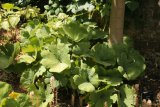Additional notes (click to expand)
Horticulture
Genus of one species of rhizomatous perennial occurring in moist woodland in E. North America. It is cultivated for its cup-shaped, white flowers (with many petals), which emerge from between the vertically folded leaves as they unfurl, in spring.
Grow in moderately fertile soil, humus rich, moist but well-drained soil in deep or partial shade. Thrives in part-day sun where soils remain reliably moist.
To propagate, divide rhizomes immediately after flowering. Pest and disease trouble free.
Brickell, C. (2003). A-Z Encyclopedia of Garden Plants. Dorling Kindersley. p.954
Medicinal
See: Sanguinaria canadensis f. multiplex
Nomenclature
Sanguina’ria Bloodroot. From Latin, sanguis, blood. All parts have copious yellowish-red sap.
Stearn, W.T. (1996). Dictionary of Plant Names for Gardeners. Cassell. p.266
Other use
Notes by Henry Oakeley from Lindley's 'Flora Medica' (1838): We grow the Canadian Bloodroot in the American bed (right of the exit to the car park at the College), where it has its transient white flowers in April/May. It is so named because of the orange sap seen when the rhizome is cut. Lindley describes it as an acrid narcotic, that in small doses slows the pulse and in smaller doses acts as a tonic. It is toxic in that the powdered rhizome ‘acts violently as an emetic’ but it is ‘a useful escharotic [= a corrosive agent] in cases of soft polypi and has been recommended in typhoid pneumonia, pthisis [tuberculosis], croup, hydrothorax, jaundice, etc...’. The thought of a compound, that burns off warty outgrowths, advocated for the treatment of infections, punctured lungs and liver disease, defies all modern logic, but I expect that our descendants will look on some of our current medicines with the same amazement. It was observed in North American herbal traditions for respiratory conditions and for the treatment of warts. It is still used, apparently, in toothpaste and mouthwashes for activity against plaque and gingivitis (whether proved or not). It contains isoquinolone alkaloids – chiefly sanguinarine - which are both toxic and mutagenic but is being investigated as a possible anti-cancer drug.
Lindley, John. (1838). Flora Medica, Longman, Orme, Brown, Green & Longmans
Toxicity
see Sanguinaria canadensis L. f. multiplex 'Plena'
Geographical distribution
- Northern America, Eastern Canada
- Northern America, Northeastern U.S.A.
Sanguinaria canadensis L.
Family: PAPAVERACEAEGenus: Sanguinaria
Species: canadensis L.
Common names: Red Pucoon or Bloodroot
Distribution summary: Canada, C. & E. U.S.A.
Habit: Perennial
Hardiness: H5 - Hardy; cold winter
Habitat: Moist woodland and riverbanks
Garden status: Not currently grown
Flowering months: March
Reason for growing: Medicinal, toxic
